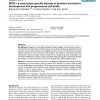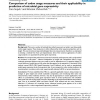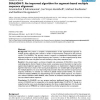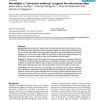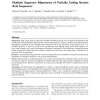BMCBI
2005
13 years 11 months ago
2005
Background: Detection of sequence homologues represents a challenging task that is important for the discovery of protein families and the reliable application of automatic annota...
BMCBI
2005
13 years 11 months ago
2005
Background: Recognition of microbial pathogens by plants triggers the hypersensitive reaction, a common form of programmed cell death in plants. These dying cells generate signals...
BMCBI
2005
13 years 11 months ago
2005
Background: We observe two trends in bioinformatics: (i) analyses are increasing in complexity, often requiring several applications to be run as a workflow; and (ii) multiple CPU...
BMCBI
2005
13 years 11 months ago
2005
Background: Functional analysis of data from genome-scale experiments, such as microarrays, requires an extensive selection of differentially expressed genes. Under many condition...
BMCBI
2005
13 years 11 months ago
2005
Background: There are a number of methods (also called: measures) currently in use that quantify codon usage in genes. These measures are often influenced by other sequence proper...
BMCBI
2005
13 years 11 months ago
2005
Background: The MEDLINE database contains over 12 million references to scientific literature, ut 3/4 of recent articles including an abstract of the publication. Retrieval of ent...
BMCBI
2005
13 years 11 months ago
2005
Background: We present a complete re-implementation of the segment-based approach to multiple protein alignment that contains a number of improvements compared to the previous ver...
BMCBI
2005
13 years 11 months ago
2005
Background: Microscopists are familiar with many blemishes that fluorescence images can have due to dust and debris, glass flaws, uneven distribution of fluids or surface coatings...
BMCBI
2005
13 years 11 months ago
2005
Background: Microscopists are familiar with many blemishes that fluorescence images can have due to dust and debris, glass flaws, uneven distribution of fluids or surface coatings...
BMCBI
2005
13 years 11 months ago
2005
Background: High quality sequence alignments of RNA and DNA sequences are an important prerequisite for the comparative analysis of genomic sequence data. Nucleic acid sequences, ...

